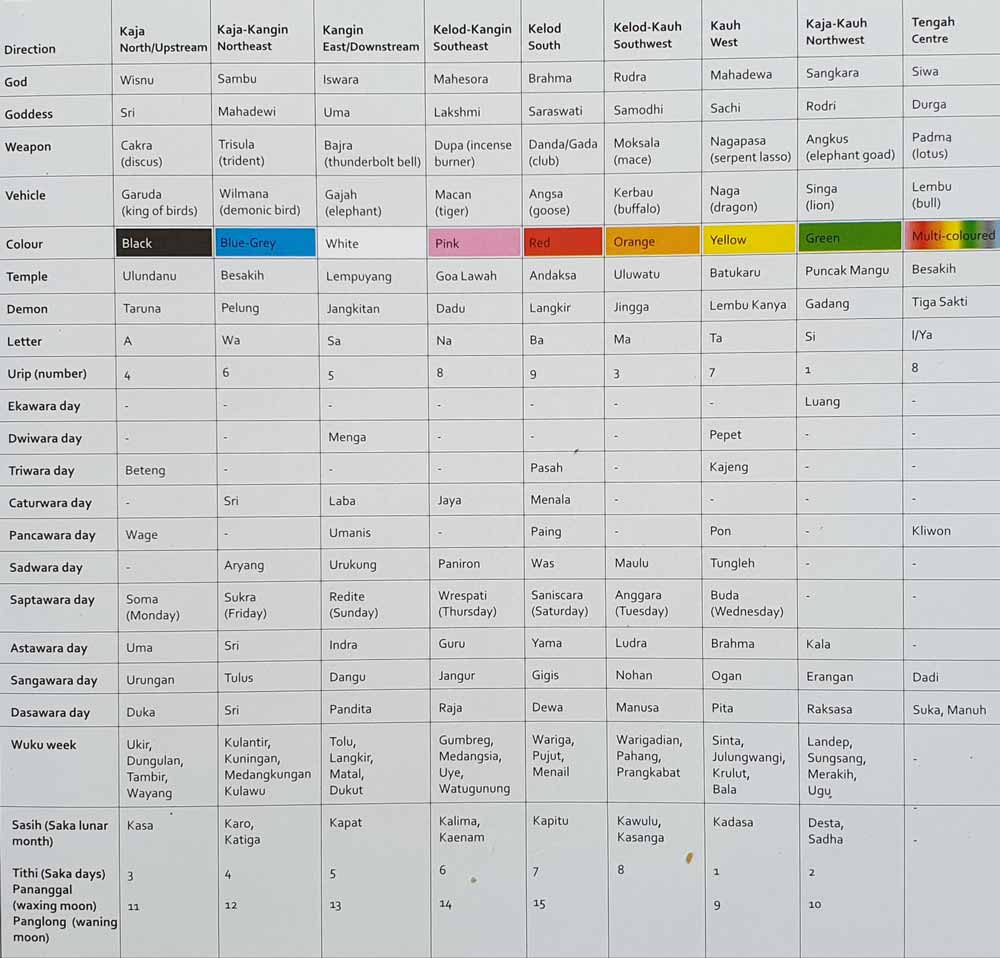Colour and movement are two of the most captivating aspects of the Bali experience. The diversity of the spectacular landscape contrasts dramatically with the vibrant and fascinating traditional culture; two of Bali’s most potent attractions. We are familiar with the creativity and colour of the offerings, the superbly decorated performance and ceremonial costumes, and the checkered black and white sarongs draped around trees. Few, however, are aware of the more profound significance of colour.

A manifestation of nature’s abundant fertility with symbolic meaning, colour is intricately related throughout all aspects of the living Balinese culture. The Nawasanga is an ingenious Balinese creation. Akin to the colour wheel, its function is layered and multi-dimensional; it is a sacred mandala of the world that maps all aspects of reality. The Swiss psychologist Carl Jung (1875-1961) introduced the mandala to western thinkers and scholars after becoming fascinated with its therapeutic powers. He believed the mandalas symbolised the psychological and spiritual self and led to greater self-awareness. Eastern philosophies have been conscious of this for aeons; Tibetan mandalas symbolically depict the gates of the cosmos.
The Nawasanga’s roots are derived from the Hindu-Buddhist traditions from the Majapahit Empire (13th-16th century). The aristocracy then relocated from East Java to Bali, merging their culture with the localized system of nature and ancestor worship. Structured within nature’s perfect symbol of unity – the circle – the Nawasanga’s configuration identifies nine specific areas considered sacred; the eight orientations of the compass and the middle of the structure. Colour identifies each of these areas along with an array of fundamental information.


The myriad of associations begins by distinguishing the basic directions, gods and goddesses, an animal, the island’s high temples, numbers, letters, sounds, sacred weapons, body parts, plants, demons, mythical heroes, tones on the musical scale and symbols. It is also linked to the Balinese calendar system’s complex system of days, weeks and months. Red, for example, is associated with South, Brahma and his goddess Saraswati, the letter Ba, the number 9, the goose, the Andaksa Temple and more distinctions of the culture.
The centre of the Nawasanga is related to Siwa and his female counterpart Durga, white, the bull, 8, the letters I/Ya and the island’s Mother Temple, Besakih. Colour-wise, white represents all of the colours of the mandala. Identified in a natural order when projected through a prism, light contains multiple frequencies of energy that manifest into individual colours. The Nawasanga depicts Black, blue/grey, white, pink, red, orange, yellow, and green in a circular motion flowing from left to right.
The Nawasanga design mirrors the lotus – or the Padma, Sanskrit for lotus. The Padma grows out of the mud yet blooms in perfect beauty above the water’s surface. This aquatic flowering plant plays an important symbolic role in many Indian religions. It is recognised as an icon for those who overcome ignorance and suffering to find enlightenment and Self-realization. Vishnu and Brahma, and the goddesses, Lakshmi and Saraswati, are regularly depicted with a lotus. Vishnu is often described as the “lotus-eyed one.” Brahma is frequently depicted in padmasana, blooming from the petals of a lotus; the unfolding petals symbolising the soul’s expansion. Padmasana is a yoga posture used for meditation.

Relevant to the Nawasanga is the emphasis on balance by including the bipartisan relationships of the male and female gods and goddesses and gods and demons. The Balinese philosophy of Rwa Bhineda means “two opposites” and that everything exists as a duality that brings a cosmic balance to the universe. The Balinese symbolise this duality using the metaphor of black and white. The world of human experience has two binary elements; order and chaos. The bridge between this duality is accessible through self-awareness of responsible thoughts and actions leading to balance. Or what Buddha referred to as the middle path.
Colour enlivens our experience while reflecting our moods. Yet, we rarely stop to think about how and why. Colour is a pathway allowing deeper appreciation of the Balinese culture; its universal philosophies are fundamentals that help solve life’s mysteries. When observing a pulsating cultural icon, the red, yellow or white of an umbrella placed above shrines, we may ponder its significance. Colour offers a unique vehicle of contemplation. Not only is it a key to greater awareness of the Balinese experience, it is a portal to encounter vast personal horizons. Equipped with snippets of knowledge from the Nawasanga, we may apply them to life.
The colours of Nawasanga relate to our body’s internal energy centres, known as chakras. Red, for example, identifies with our base chakra at the end of the spine. It is linked to specific organs and other aspects of our being. When quietly focusing on these energy wheels and imagining them spinning, we actively stimulate the body’s self-healing capacity while reducing the mind’s chatter and accessing inner peace. This contemplation is an initial pathway into a broader practice that includes other aspects of knowledge within the Nawasanga.

The colour wheel is the magical terrain of the painter. By manipulating the relationship between the primary and secondary colours as depicted on the wheel, descript and non-descript imagery ignites the suggestive power of the mind. The wisdom of the Balinese colour mandala has been integrated with a unique art therapy modality devised by renowned Ubud artist and academic Wayan Karja.
Pioneering Western abstract painter and art theorist Wassily Kandinsky (1866–1944 Russia) writes in ‘Concerning the Spiritual in Art’, “Colour is the keyboard, the eyes are the harmonies, the soul is the piano with many strings. The artist is the hand that plays, touching one key or another, to cause vibrations in the soul.”


